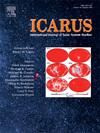Exobase and homopause altitudes in the Martian upper atmosphere: Solar cycle variability and response to the 2018 global dust storm
IF 2.5
2区 物理与天体物理
Q2 ASTRONOMY & ASTROPHYSICS
引用次数: 0
Abstract
Understanding the composition of volatile gases in the Martian upper atmosphere and the mechanisms governing their escape into outer space is crucial for unraveling planetary evolution. Two critical neutral atmospheric boundaries, the exobase and the homopause, play key roles in this context. In this study, we conducted a detailed analysis of the exobase and homopause altitudes derived from measurements by the Neutral Gas and Ion Mass Spectrometer (NGIMS) aboard the Mars Atmosphere and Volatile Evolution (MAVEN) spacecraft. The exobase and homopause altitudes observed in this study range from 140 to 200 km and 90–135 km, respectively, broadly agreeing with values reported in previous studies. Using extended observations, this study reveals significant interannual variability in these altitudes. Both the exobase and homopause were found to be higher during moderate solar activity compared to solar minimum. During moderate solar activity, these two altitudes rise and fall nearly synchronously, while this coupling weakens during solar minimum. Seasonal trends are also pronounced, with elevated altitudes observed during perihelion and in the summer hemisphere, particularly during the southern summer. These findings suggest that enhanced solar activity during moderate solar periods increases atmospheric heating, elevating atmospheric scale heights and causing the exobase and homopause to rise and fall in-phase. In contrast, during solar minimum, weaker thermal forcing reduces the influence of atmospheric expansion, allowing gravity wave activity to dominate the variability of the homopause. During the 2018 global dust storm (GDS), exobase altitudes were elevated with reduced sinusoidal amplitude, while homopause altitudes exhibited significant fluctuations. These results indicate that thermospheric expansion raises the altitudes of both boundaries during the GDS, but enhanced gravity wave activity introduces substantial fluctuations in the homopause altitude, disrupting its coupling with the exobase and resulting in a phase shift between the variations of these two critical altitudes.
火星上层大气的外基和同顶高度:太阳周期变化及其对2018年全球沙尘暴的响应
了解火星上层大气中挥发性气体的组成及其逃逸到外太空的机制,对于解开行星演化之谜至关重要。在这种情况下,两个关键的中性大气边界,即外基和同层顶,起着关键作用。在这项研究中,我们对火星大气和挥发性演化(MAVEN)航天器上的中性气体和离子质谱仪(NGIMS)测量的外基和同质顶高度进行了详细分析。本研究观测到的外底高度和同顶高度分别为140 ~ 200 km和90 ~ 135 km,与以往研究报告的值基本一致。通过扩展观测,本研究揭示了这些海拔高度的显著年际变化。与太阳极小期相比,在中度太阳活动期间,外底和同顶都较高。在中度太阳活动期间,这两个高度几乎同步上升和下降,而这种耦合在太阳极小期减弱。季节性趋势也很明显,在近日点和夏季观测到海拔升高,特别是在南部夏季。这些发现表明,在太阳活动中,太阳活动的增强增加了大气加热,提高了大气尺度高度,并导致外基和同层顶同步上升和下降。相反,在太阳活动极小期,较弱的热强迫减少了大气膨胀的影响,使重力波活动支配了同层顶的变率。在2018年全球沙尘暴(GDS)期间,外基高度呈正弦振幅减小的上升趋势,而同顶高度呈显著波动。这些结果表明,在GDS期间,热层膨胀提高了两个边界的高度,但重力波活动的增强引起了均匀顶高度的大幅波动,破坏了其与外基的耦合,并导致这两个临界高度变化之间的相移。
本文章由计算机程序翻译,如有差异,请以英文原文为准。
求助全文
约1分钟内获得全文
求助全文
来源期刊

Icarus
地学天文-天文与天体物理
CiteScore
6.30
自引率
18.80%
发文量
356
审稿时长
2-4 weeks
期刊介绍:
Icarus is devoted to the publication of original contributions in the field of Solar System studies. Manuscripts reporting the results of new research - observational, experimental, or theoretical - concerning the astronomy, geology, meteorology, physics, chemistry, biology, and other scientific aspects of our Solar System or extrasolar systems are welcome. The journal generally does not publish papers devoted exclusively to the Sun, the Earth, celestial mechanics, meteoritics, or astrophysics. Icarus does not publish papers that provide "improved" versions of Bode''s law, or other numerical relations, without a sound physical basis. Icarus does not publish meeting announcements or general notices. Reviews, historical papers, and manuscripts describing spacecraft instrumentation may be considered, but only with prior approval of the editor. An entire issue of the journal is occasionally devoted to a single subject, usually arising from a conference on the same topic. The language of publication is English. American or British usage is accepted, but not a mixture of these.
 求助内容:
求助内容: 应助结果提醒方式:
应助结果提醒方式:


